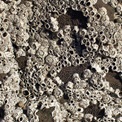
The bioadhesive produced by barnacles is stronger than any man-made glue
RESEARCHERS at Newcastle University, UK, have solved the mystery of how barnacles glue themselves so tightly to wet rock, and it’s because they release a lipid “primer” first.
The bioadhesive produced by barnacles is stronger than any man-made glue, and crucially, can stick to any surface in any conditions. Some marine organisms, such as tubeworms, make bioadhesive by mixing together one negatively-charged and one positively-charged component, similar to an epoxy resin, before releasing it. However, researchers suspected that this “mix-and-release” system was not how the barnacle adhesive worked.
“What we saw was that one component was released first and, into this, the second component was added,” lead researcher Nick Aldred tells tce.
He and his team from Newcastle’s School of Marine Science and Technology found that the first component released is a mixture of lipids which acts as the primer and effectively displaces the water from the rock surface. Then, a mixture of phosphoproteins, the adhesive component, is released. As well as displacing the water, the lipids prevent the protein component from becoming too saturated and so stops it spreading too far. Aldred and his colleagues also suspect that the lipids have a protective function, preventing marine bacteria from breaking down the protein-based adhesive.
The discovery has been helped by advances in microscope technology, which has allowed Aldred and his team to study the process in living animals.
“We can get compositional and molecular information by other methods, but they dont explain the mechanism. Theres no substitute for seeing things with your own eyes,” says Aldred.
They used techniques including 2-photon microscopy, which uses long-wavelength light to illuminate fluorescent labelled samples. This is much less damaging than traditional techniques, which would kill the tissues being imaged. The images clearly showed the separation of lipid-producing and protein-producing glands in the barnacle cyprid larvae and that the lipid substance was released before the phosphoprotein substance.
“It’s an incredibly clever natural solution to this problem of how to deal with a water barrier on a surface. It will change the way we think about developing bio-inspired adhesives that are safe and already optimised to work in conditions similar to those in the human body,” says Aldred.
The discovery could lead to the development of new synthetic bioadhesives for medical implants and microelectronics. It could also help the shipping industry develop better anti-fouling coatings for ships, to prevent barnacles and other organisms sticking to ships’ hulls, which increases drag and fuel use.
The above story is based on materials by TCE Today.
Note: Materials may be edited for content and length. For further information, please contact the source cited above.
Copyright © 2024 International Society of Bionic Engineering All Rights Reserved
吉ICP备11002416号-1



 Attachment:
Attachment:






